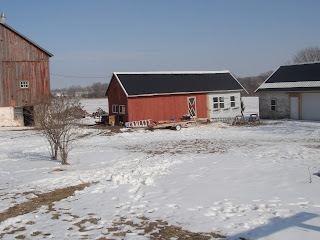When we last posted a blog, our Tamworth sow, Stella, had just arrived at our farm and was adjusting to her new life in our fields. She had a wonderful time of it--eating and digging in the cover crop first, then, later, munching on organic, heirloom corn stalks and cobs as they stood in our garden.
 |
Stella, mowing down a cover crop,
Summer 2012 |
We visited her at least once a day, usually bringing her a treat or two from the garden (tomatoes and cauliflower top her list of favorites), but she always seemed sad to see us leave. Pigs don't like to be alone. They are very social creatures, living in groups even in the wild. We knew that Stella wouldn't be alone for long, what with her piglets coming soon and our plan to save one of her girls to live with her from now on, but we just couldn't convince Stella of that.
 |
Co-engineer, Raphael,
in the creep area of Stella's farrowing pen |
As summer waned, and the leaves began to turn color, we knew it was time to get serious about building a farrowing pen for Stella in the big, old barn. Kathy came up with a skeleton-like plan which showed how large each stall should be, but the real engineering took place late in the evening each night as Robin and Raphael took that plan and turned it into real, tangible walls and gates.
 |
| Stella investigates her new home |
On conventional pig farms, sows give birth in farrowing crates, narrow areas which confine the sow, not even allowing her to turn around. The reason given is that this helps to prevent the sow from lying on her piglets. The reality is that it restricts the sow's movement, even to the point of causing bed sores, and can wreak havoc with nursing, as some of the sow's teats may be blocked by the bars which hold the sow. So what about the danger of sows crushing their piglets? On commercial farms, sows are selected based on number of pigs in a litter, leanness of meat, and body conformation. On small, private farms, and in heritage breed pigs in general, sow selection is based, among other things, on good mothering skills. This gives us sows that know how to care for their pigs--including how to avoid lying on them--even when not confined in farrowing crates.
 |
| Marcelino and Stella at the farrowing pen |
When planning Stella's pen, we knew we wanted to create a farrowing pen which gives the sow a larger area to live in, plus an area for the piglets to retreat to when they are ready for a nap. This area, called the creep, includes a heat lamp to keep the piglets toasty warm. Eventually, the creep will also have a piglet feeder with freshly-ground, high-protein, organic feed for the little ones. A partition which begins eight inches above the floor separates Stella's area from the creep. This keeps Stella out of the piglets' area, but allows the piglets free access to their mom anytime they'd like.
 |
| Surprise! The piglets are here! |
Upon returning home from church last Sunday, we found Stella accompanied by seven piglets! She probably had begun farrowing (giving birth) more than an hour before, as the piglets continued to come about every 15 minutes thereafter. She farrowed 14 piglets, with 10 surviving. Way to go, Stella!
 |
| Mama Stella nursing her piglets |
 |
Proud Swine Manager,
sketching the new family |
 |
Piglets napping in the creep,
with Stella looking on |
 |
| Ten Little Sausages |
 |
| Life is Good |












































